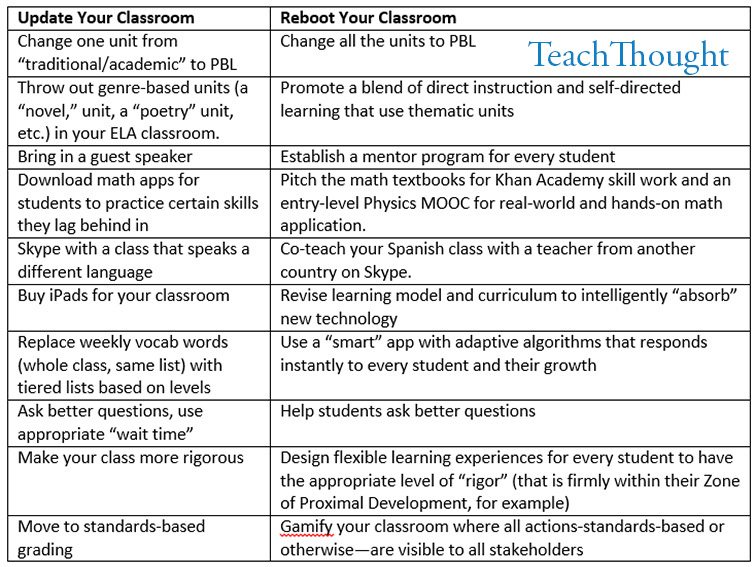 The Difference Between Updating & Rebooting Your Classroom
The Difference Between Updating & Rebooting Your Classroom
by Terry Heick
As they do in other fields full of human beings, money, and systems, discussions about teaching and learning usually tend towards two extremes. Either there sky is falling panic, or the more things change the more they stay the same indifference.
There really isn’t any “truth” here worth finding, only perspective: What you believe, and the way those beliefs align with the thinking all around you. You’d be hard-pressed, however, to find a teacher that believed their classroom was as modern, cutting edge, and efficient as it could get–really, honest-to-goodness believed that.
Most teachers are, in lieu of the frenetic appearance, smart and self-aware. They’re at the very least educated, certified, and endlessly trained and developed. They constantly collaborate, reflect, and refine what they do as a matter of policy, peer pressure, and more than likely at least one growth plan. On top of that, you can add in everything they do to improve their teaching because they want to—like read this.
And these smart, connected, and trained educators are probably well aware of the constant change in education. Assessment, student habits, technology, school and district “non-negotiables,” trends in learning, communities, and the staff around them all change constantly—which implies that their craft needs changing, too.
Either updated, or rebooted.
Rebooting As A Metaphor
If you’ve ever used a computer, tablet, or smartphone for several weeks at a time, you’re probably aware of how much rebooting said device helps when things get slow and buggy. (Not saying the learning in your classroom is slow and buggy. I’m just sayin’.)
Updates are more common. They are even usually externally-driven–pushed to a phone or tablet automatically. Reboots don’t happen unless you, as a user, make them happen. (Well, unless it crashes. Work with me here.)
What does “updating” look like in a classroom? You throw out a unit. You move this unit here, and that unit there. Change this novel for that. Use a project-based learning unit at the end of the year instead of the cumulative essay + multiple-choice exam you’ve used in the past. Replacing the one-size-fits-all weekly vocab list with something tiered.
Rebooting is a bit more intensive—not necessarily starting from scratch, but something that definitely touches everything you do, and ends up visibly altering the work the students do. Throwing out genre-based units in your ELA classroom. Moving to a full on peer-tutoring model in your classroom. Pitching the math textbooks for Khan Academy skill work and an entry-level Physics MOOC for real-world and hands-on math application. Co-teaching your Spanish class with a teacher from another country on Skype.
Below are 10 examples to help you see the difference. Again–one isn’t better than the other. This isn’t a call to reboot everything. (Not this time, anyway.) This is a bit more relaxed, and complimentary to all the work you’ve already put in to what you do.
You’re smart.
You’re trained.
You probably have an instinct which your classroom deserves.
Hopefully this comparative metaphor of updating versus rebooting can help you reset your own thinking as we head towards summer 2014, a time where this kind of analysis and reflection make sense.
The Difference Between Updating And Rebooting Your Classroom: 10 Examples
 Adapted image attribution flickr user nasagoddardspaceflightcenter; The Difference Between Updating And Rebooting Your Classroom
Adapted image attribution flickr user nasagoddardspaceflightcenter; The Difference Between Updating And Rebooting Your Classroom

